| |
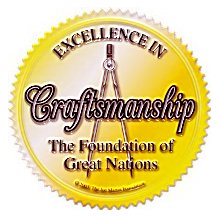 |
The Joe Martin Foundation for
Exceptional Craftsmanship
Presents
The On-line Internet
Craftsmanship Museum
|
| |
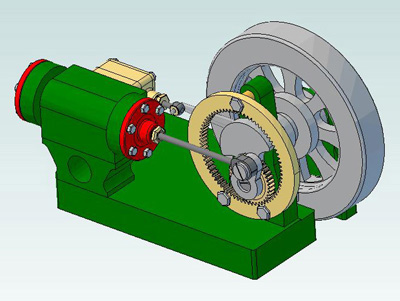 Geared Steam
Engine by Joe Martin (Click on image to enlarge) |
Featuring Alibre Design 3D CAD Design Gallery |
Recent developments in 3D Computer Aided Design (CAD) have brought the price of
programs down to where a home shop user can have access to design tools that
rival that of the professional programs purchased by engineers and big
companies. Programs like Solidworks, Pro/E, Catia, Inventor and SolidEdge cost
many thousands of dollars. However, for the small business or home shop users,
programs like Alibre Design offer all the important features to design
sophisticated parts and assemblies for less than $200. We present here examples
of clever work done entirely in the computer using 3D CAD programs. There are two
categories: 1) Projects re-created in 3D from existing 2D plans and 2) New
projects designed from scratch in the computer.
The old way vs. the new way to design and build parts—Computer
Craftsmanship
The old way was to sketch out an idea on paper and then draw up a set of plans
either on a drawing board or in a 2D CAD program like AutoCAD. Then a prototype
would be built from the plans and parts fitted together. Once the inevitable
mistakes were discovered and design changes were made, eventually you ended up
with a corrected set of plans and an actual working prototype you could look at
from any angle and move the parts to make sure it was what you wanted before
going into production.
That has all changed with 3D design programs. Now the designer can start making
parts right in the computer. He can rotate them around and visualize them from
all angles on the screen. He can color them. He can build up assemblies of
various parts to make sure they fit together. He can then apply constraints to
the various parts so they move in the proper relationship to each other, and he
can animate the whole assembly right on the computer screen. He can also easily
convert the drawing into conventional 2D plans with dimensions, and he can
create cross-sectional views and even exploded views with just a few simple
commands. All of this is before the first part is even made.
Once the assembly is completed in the computer, there are two ways to translate
that into a physical object you can hold in your hand. One is to use modern 3D
printing technology. The drawing is sent to a 3D printer where it goes from a
drawing directly to reality. Various technologies using plaster, plastic and
even metal build a part in thin layers. Molds for the part can also be built in
the printer so the part can be cast. The other method is to translate the
information in the drawing into a text based language called G-code. This is the
language modern CNC machines understand, and they can machine the design from a
solid block of material (anything from foam to metal) to produce the actual
parts exactly like the ones in the drawing. This is the way things are done now
in the industrial world.
For those interested in learning what the Alibre 3D CAD program can do,
CLICK HERE

The 3D CAD Gallery
Industrial Archeology—Recreating
objects and assemblies from existing plans
|
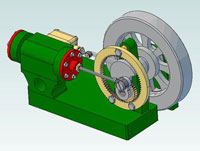 |
Geared steam engine by Joe Martin.
The
mechanism features a planetary gear the circles inside a ring gear,
keeping the connecting rod level.
Plans: www.John-Tom.com |
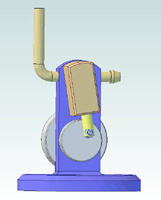 |
A small oscillating steam engines called "Millie"
by Joe Martin
Plans: From plans reprinted in
Tabletop Machining
by Joe Martin from a design by Ed Warren originally published in
ModelTec magazine |
 |
Opposed piston steam engine by Joe Martin
Plans: www.John-Tom.com |
Using the 3D design process to
create new projects
|

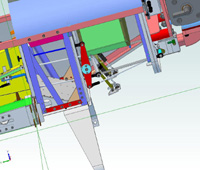
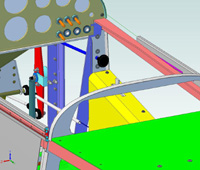 |
Model R/C Airplane design by Jerry Nelson
Jerry is an R/C flyer, retired hobby shop merchandiser and former
user of SolidEdge 3D CAD software. The plans were taken from a
full-size homebuilt airplane and scaled down to 1/4 size. Like the
real plane, the model will be built using metal panels with
fiberglass cowling, wheel pants and wing and elevator tips. In the
drawing Jerry was able to confirm that fuel tanks will fit, linkages
will clear bulkheads, etc. Working out problems in advance in the
drawing assures perfect part fits the first time when the model is
actually built.
Jerry's design is based on is the
Thatcher CX4, a
VW-powered, single-place sport aircraft that has a wingspan of 24'
and weighs just 520 pounds empty.
NOTE: Jerry Nelson, along with Joe Martin, Bud Crane and Ed Shipe
were the founders of the sport of Formula 1 R/C pylon racing in the
1960's. |
Return to Craftsmanship Museum Home page
Return to Craftsmanship Museum Rooms page








